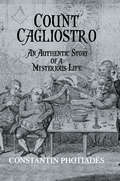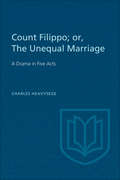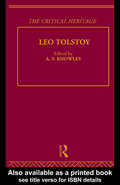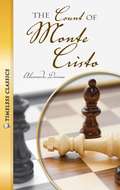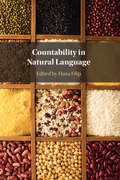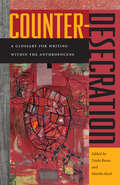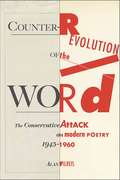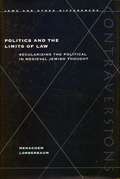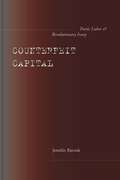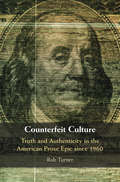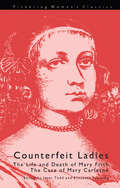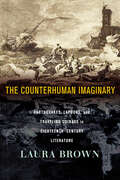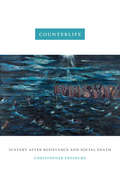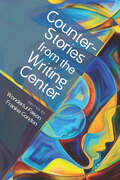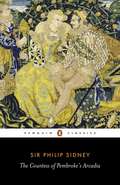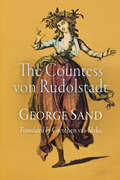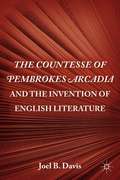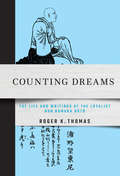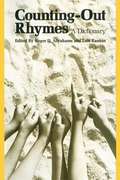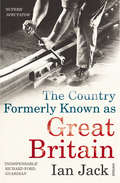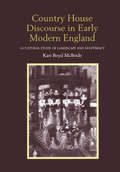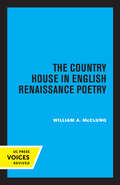- Table View
- List View
Count Cagliostro: An Authentic Story Of A Mysterious Life
by PhotiadesThis is an engaging account of the life of Count Cagliostro, who donned such varied personas as magician, alchemist, colonel, swindler, mythical priest and founder of Egyptian masonry. Photiades details the Count's life from its humble beginnings in Palermo to his adventures in Europe and finally his demise in a remote fortress.
Count Filippo; or The Unequal Marriage: A Drama in Five Acts
by Charles Heavysege Douglas LochheadA five-act tragedy in blank verse. The play is founded upon the old problem of an unnatural and ill-omened union between youth and age.
Count Leo Nikolaevich Tolstoy: The Critical Heritage (Collected Critical Heritage Ser. #Series 2)
by A. V. KnowlesThis set comprises 40 volumes covering 19th and 20th century European and American authors. These volumes will be available as a complete set, mini boxed sets (by theme) or as individual volumes. This second set compliments the first 68 volume set of Critical Heritage published by Routledge in October 1995.
The Count Of Monte Cristo (Timeless Classics Ser.)
by Alexandre Dumas Stephen FeinsteinOn the night before his wedding, an innocent young man is arrested and imprisoned. How could such a thing have happened? When he finally discovers the truth, he bitterly plots revenge. Then he escapes of prison and begins to punish his enemies, one by one. <P><P>Timeless Classics designed for the struggling reader and adapted to retain the integrity of the original classic. These classic novels will grab a students attention from the first page. Included are eight pages of end-of-book activities to enhance the reading experience.
The Count of Monte Cristo SparkNotes Literature Guide (SparkNotes Literature Guide Series #22)
by SparkNotes Alexandre DumasSparkNotes Literature Guides:Making the reading experience fun! When a paper is due, and dreaded exams loom, heres the lit-crit help students need to succeed! SparkNotes Literature Guides make studying smarter, better, and faster. They provide chapter-by-chapter analysis; explanations of key themes, motifs, and symbols; a review quiz; and essay topics. Lively and accessible, SparkNotes is perfect for late-night studying and paper writing. Includes:An A+ Essay—an actual literary essay written about the Spark-ed book—to show students how a paper should be written.16 pages devoted to writing a literary essay including: a glossary of literary termsStep-by-step tutoring on how to write a literary essayA feature on how not to plagiarize
Countability in Natural Language
by Hana FilipThis book focuses on current theoretical and empirical research into countability in the nominal domain, and to a lesser extent in the verbal domain. The presented state-of-the-art studies are situated within compositional semantics combined with the theory of mereology, and draw on a wealth of data, some of which have hitherto been unknown, from a number of typologically distinct languages. Some contributions propose enrichments of classical extensional mereology with topological and temporal notions as well as with type theory and probabilistic models. The book also presents analyses that rely on cutting-edge empirical research (experimental, corpus-based) into meaning in language. It is suitable as a point of departure for original research or material for seminars in semantics, philosophy of language, psycholinguistics and other fields of cognitive science. It is of interest not only to a semanticist, but also to anybody who wishes to gain insights into the contemporary research into countability.
Counter-Desecration: A Glossary for Writing Within the Anthropocene
by Linda Russo and Marthe ReedNew vocabulary for a world on the brink The Anthropocene is a term proposed for the present geological epoch (from the time of the Industrial Revolution onwards) to highlight the role of humanity in the transformation of earth's environment globally, has become the subject of scholarship not only in the sciences, but also in the arts and humanities as well. Ecopoetics, a multidisciplinary approach that includes thinking and writing on poetics, science, and theory as well as emphasizing innovative approaches common to conceptual poetry, rose out of the late 20th-century awareness of ecology and concerns of environmental disaster. Collected from contributors including Brenda Hillman, Eileen Tabios, and Christopher Cokinos, and together a monument to human responsiveness and invention, Counter-Desecration is a book of ecopoetics that compiles terms—borrowed, invented, recast—that help configure or elaborate human engagement with place. There are no analogous volumes in the field of ecocriticism and ecopoetics. The individual entries, each a sketch or a notion, through some ecopoetic lens—anti-colonialism, bioregionalism, ecological (im)balance, indigeneity, resource extraction, extinction, habitat loss, environmental justice, queerness, attentiveness, sustainability—focus and configure the emerging relations and effects of the Anthropocene. Each entry is a work of art concerned with contemporary poetics and environmental justice backed with sound observation and scholarship.
Counter-revolution of the Word
by Alan FilreisDuring the Cold War an unlikely coalition of poets, editors, and politicians converged in an attempt to discredit--if not destroy--the American modernist avant-garde. Ideologically diverse yet willing to bespeak their hatred of modern poetry through the rhetoric of anticommunism, these "anticommunist antimodernists," as Alan Filreis dubs them, joined associations such as the League for Sanity in Poetry to decry the modernist "conspiracy" against form and language. In Counter-revolution of the Word Filreis narrates the story of this movement and assesses its effect on American poetry and poetics.Although the antimodernists expressed their disapproval through ideological language, their hatred of experimental poetry was ultimately not political but aesthetic, Filreis argues. By analyzing correspondence, decoding pseudonyms, drawing new connections through the archives, and conducting interviews, Filreis shows that an informal network of antimodernists was effective in suppressing or distorting the postwar careers of many poets whose work had appeared regularly in the 1930s. Insofar as modernism had consorted with radicalism in the Red Decade, antimodernists in the 1950s worked to sever those connections, fantasized a formal and unpolitical pre-Depression High Modern moment, and assiduously sought to de-radicalize the remnant avant-garde. Filreis's analysis provides new insight into why experimental poetry has aroused such fear and alarm among American conservatives.
Counterculture Colophon: Grove Press, the Evergreen Review, and the Incorporation of the Avant-Garde
by Loren GlassResponsible for such landmark publications asLady Chatterley's Lover,Tropic of Cancer,Naked Lunch, Waiting for Godot,The Wretched of the Earth, andThe Autobiography of Malcolm X, Grove Press was the most innovative publisher of the postwar era. Counterculture Colophontells the story of how the press and its house journal,The Evergreen Review, revolutionized the publishing industry and radicalized the reading habits of the "paperback generation. " In the process, it offers a new window onto the 1960s, from 1951, when Barney Rosset purchased the fledgling press for $3,000, to 1970, when the multimedia corporation into which he had built the company was crippled by a strike and feminist takeover. Grove Press was not only responsible for ending censorship of the printed word in the United States but also for bringing avant-garde literature, especially drama, into the cultural mainstream as part of the quality paperback revolution. Much of this happened thanks to Rosset, whose charismatic leadership was crucial to Grove's success. With chapters covering world literature and the Latin American boom, including Grove's close association with UNESCO and the rise of cultural diplomacy; experimental drama such as the theater of the absurd, the Living Theater, and the political epics of Bertolt Brecht; pornography and obscenity, including the landmark publication of the complete work of the Marquis de Sade; revolutionary writing, featuring Rosset's daring pursuit of the Bolivian journals of Che Guevara; and underground film, including the innovative development of the pocket filmscript, Loren Glass covers the full spectrum of Grove's remarkable achievement as a communications center of the counterculture.
Counterfeit Capital: Poetic Labor and Revolutionary Irony
by Jennifer BajorekCounterfeit Capital is a comparative and interdisciplinary study exploring the unexpected yet essential relationship between irony and capital in the texts of Baudelaire and Marx. It argues for the renewed relevance of their work to contemporary thinking about the place of aesthetic and cultural experience in social and political life and articulates their poetic and philosophical innovations with their political statements in new and powerful ways. Through readings of Baudelaire's poetry and prose and Marx's Capital, this book illuminates their ongoing contribution to our understanding of themes and topics at the forefront of contemporary theoretical debate, including the effects of new technologies on the means of human action and transformation and the prospects for community and memory under capitalism. This book also revisits Walter Benjamin's interpretations of the philosopher and the poet. Rereading Baudelaire and Marx together with the unplumbed lessons of Benjamin's interpretations, it contributes to a growing body of interdisciplinary scholarship on the political dimensions and effects of language and to the current rethinking, in Marxist and post-Marxist theory, of conceptions of political time and agency.
Counterfeit Culture: Truth and Authenticity in the American Prose Epic since 1960 (Cambridge Studies in American Literature and Culture #181)
by Rob TurnerCounterfeit Culture explores the possibility of writing epic in an age of alternative facts. Examining six attempts to forge an American prose epic since 1960, this study goes on to trace a national tradition of inauthenticity, stretching back across four centuries. In works by authors such as Pynchon, Gaddis and Burroughs, the contemporary turn away from truth and authenticity can be seen as a return to an established line of literary tricksters and confidence men, with tropes of fraud and artifice running deep in the American grain. Combining archival work with historically-inflected analysis of literary narrative, this book ranges through questions of identity, technology, history, and music in its engagement. From Marguerite Young's inquiry into psychological disintegration to William T. Vollmann's ongoing cycle of false histories, the study introduces a new reading of the American epic.
Counterfeit Ladies: The Life and Death of Moll Cutpurse and the Case of Mary Carleton (Pickering Women's Classics)
by Elizabeth SpearingBiographies of two 17th-century female criminals, both celebrated in their day. These are the first editions published since the 17th century.
The Counterhuman Imaginary: Earthquakes, Lapdogs, and Traveling Coinage in Eighteenth-Century Literature
by Laura BrownThe Counterhuman Imaginary proposes that alongside the historical, social, and institutional structures of human reality that seem to be the sole subject of the literary text, an other-than-human world is everywhere in evidence. Laura Brown finds that within eighteenth-century British literature, the human cultural imaginary can be seen, equally, as a counterhuman imaginary—an alternative realm whose scope and terms exceed human understanding or order.Through close readings of works by Daniel Defoe, Jonathan Swift, and Alexander Pope, along with lapdog lyrics, circulation narratives that give agency to inanimate objects like coins and carriages, and poetry about the Lisbon earthquake of 1755, Brown traces the ways presence and power of the nonhuman—weather, natural disasters, animals, even the concept of love—not only influence human creativity, subjectivity, and history but are inseparable from them. Traversing literary theory, animal studies, new materialism, ecocriticism, and affect theory, The Counterhuman Imaginary offers an original repudiation of the centrality of the human to advance an integrative new methodology for reading chaos, fluidity, force, and impossibility in literary culture.
Counterlife: Slavery after Resistance and Social Death
by Christopher FreeburgIn Counterlife Christopher Freeburg poses a question to contemporary studies of slavery and its aftereffects: what if freedom, agency, and domination weren't the overarching terms used for thinking about Black life? In pursuit of this question, Freeburg submits that current scholarship is too preoccupied with demonstrating enslaved Africans' acts of political resistance, and instead he considers Black social life beyond such concepts. He examines a rich array of cultural texts that depict slavery—from works by Frederick Douglass, Radcliffe Bailey, and Edward Jones to spirituals, the television cartoon The Boondocks, and Quentin Tarantino's Django Unchained—to show how enslaved Africans created meaning through artistic creativity, religious practice, and historical awareness both separate from and alongside concerns about freedom. By arguing for the impossibility of tracing slave subjects solely through their pursuits of freedom, Freeburg reminds readers of the arresting power and beauty that the enigmas of Black social life contain.
Countermodernism and Francophone Literary Culture: The Game of Slipknot
by Keith L. WalkerKeith L. Walker traverses the traditionally imposed boundaries of geography and race as he examines the literary culture produced by French speakers and writers born outside France. Focusing on the commonalities revealed in their shared language and colonial history, Walker examines for the first time the work of six writers who, while artistically distinct and geographically scattered, share complex sensibilities regarding their own relationship to France and the French language and, as he demonstrates, produce a counterdiscourse to their colonizers' modern literary traditions.Martinique, French Guyana, Senegal, Morocco, and Haiti serve as the stage for the struggle these writers have faced with French language and culture, a struggle influenced by the legacy of Aimé Césaire. In his stand against the modernist principles of Charles Baudelaire, Walker argues, Césaire has become the preeminent francophone countermodernist. A further examination of the relationships between Césaire and the writers Léon Gontron Damas, Mariama Bâ, Tahar Ben Jelloun, Ken Bugul, and Gérard Étienne forms the core of the book and leads to Walker's characterization of francophone literature as having "slipped the knot," or escaped the snares of the familiar binary oppositions of modernism. Instead, he discovers in these writers a shared consciousness rooted in an effort to counter and denounce modernist humanist discourse and pointing toward a new subjectivity formed through the negotiation of an alternative modernity.Countermodernism and Francophone Literary Culture will engage readers interested in French literature and in postcolonial, Caribbean, African, American, and francophone studies.
CounterStories from the Writing Center
by Wonderful Faison Frankie CondonCounterStories from the Writing Center gathers emerging scholars of colour and their white accomplices to challenge some of the most cherished lore about the work of writing centres. Writing within an intersectional feminist frame, this volume’s contributors name and critique the dominant role that white, straight, cis-gendered women have played in writing centre administration as well as in the field of writing centre studies. This work will shake the field’s core assumptions about itself. Practicing what Derrick Bell has termed “creative truth telling,” these writers are not concerned with individual white women in writing centres but with the social, political, and cultural capital that is the historical birthright of white, straight, cis-gendered women, particularly in writing centre studies. The essays collected in this volume test, defy, and overflow the bounds of traditional academic discourse in the service of powerful testimony, witness, and counterstory. CounterStories from the Writing Center is a must-read for writing centre directors, scholars, and tutors who are committed to antiracist pedagogy and offers a robust intersectional analysis to those who seek to understand the relationship between the work of writing centres and the problem of racism. Accessible and usable for both graduate and undergraduate students of writing centre theory and practice, this work troubles the field’s commonplaces and offers a rich envisioning of what writing centres materially committed to inclusion and equity might be and do. Contributors: Dianna Baldwin, Nicole Caswell, Mitzi Ceballos, Romeo Garcia, Neisha-Anne Green, Doug Kern, T. Haltiwanger Morrison, Bernice Olivas, Moira Ozias, Trixie Smith, Willow Trevino
The Countess of Pembroke's Arcadia (C Oet T Oxford English Texts)
by Philip SidneyBasilus, a foolish old duke, consults an oracle as he imperiously wishes to know the future, but he is less than pleased with what he learns. To escape the oracle's horrific prophecies about his family and kingdom he withdraws into pastoral retreat with his wife and two daughters. When a pair of wandering princes fall in love with the princesses and adopt disguises to gain access to them, all manner of complications, both comic and serious, ensue. Part-pastoral romance, part-heroic epic, Sidney's long narrative work was hugely popular for centuries after its first publication in 1593, inspiring two sequels and countless imitations, and contributing greatly to the development of the novel.
The Countess von Rudolstadt
by George Sand Gretchen Van SlykeThe first translation of The Countess von Rudolstadt in more than a century brings to contemporary readers one of George Sand's most ambitious and engaging novels, hailed by many scholars of French literature as her masterpiece. Consuelo, or the Countess von Rudolstadt, born the penniless daughter of a Spanish gypsy, is transformed into an opera star by the great maestro Porpora. Her peregrinations throughout Europe (especially Vienna, Berlin, and the Bohemian forest), become a quest undertaken on a number of levels: as a singer, as a woman, and as an unwilling subject of alienation and oppression.Sand's heroine moves through a mid-eighteenth-century Europe where absolute rulers mingle with Enlightenment philosophers and gender-bending members of secret societies plot moral and political revolution. As the old order breaks down, she undergoes a series of grueling initiations into radically redefined notions of marriage and social organization. In a novel by equal measures philosophical and lurid, nothing is what it seems. Written some fifty years after the French Revolution, the book taps into many of the political and religious currents that contributed to that social upheaval—and aims to channel their potential for future change.Fed by Sand's rich imagination and bold aspirations for social reform, The Countess von Rudolstadt is a sinuous novel of initiation, continuing the coming of age tale of the titular heroine of Sand's earlier Consuelo and drawing on such diverse models as Ann Radcliffe's Gothic tales and Goethe's Wilhelm Meister.
The Countesse of Pembrokes Arcadia and the Invention of English Literature
by Joel B. DavisRevises the semiotic paradigm of the early modern 'literary system' dominant since 1983 by adapting methods entailed in the idea that literary works emerge through a series of semiotic events. Davis analyzes Philip Sidney's Arcadia and Astrophil and Stella to demonstrate how design elements stage the scene of reading these works.
Counting Dreams: The Life and Writings of the Loyalist Nun Nomura Bōtō
by Roger K. ThomasCounting Dreams tells the story of Nomura Bōtō, a Buddhist nun, writer, poet, and activist who joined the movement to oppose the Tokugawa Shogunate and restore imperial rule. Banished for her political activities, Bōtō was imprisoned on a remote island until her comrades rescued her in a dramatic jailbreak, spiriting her away under gunfire. Roger K. Thomas examines Bōtō's life, writing, and legacy, and provides annotated translations of two of her literary diaries, shedding light on life and society in Japan's tumultuous bakumatsu period and challenging preconceptions about women's roles in the era.Thomas interweaves analysis of Bōtō's poetry and diaries with the history of her life and activism, examining their interrelationship and revealing how she brought two worlds—the poetic and the political—together. Counting Dreams illustrates Bōtō's significant role in the loyalist movement, depicting the adventurous life of a complex woman in Japan on the cusp of the Meiji Restoration.
Counting-Out Rhymes: A Dictionary
by Roger D. Abrahams Lois RankinEeny, meeny, figgledy, fig. Delia, dolia, dominig,Ozy, pozy doma-nozy,Tee, tau, tut,Uggeldy, buggedy, boo!Out goes you. (no. 129)You can stand,And you can sit,But, if you play,You must be it. (no. 577)Counting-out rhymes are used by children between the ages of six and eleven as a special way of choosing it and beginning play. They may be short and simple ("O-U-T spells out/And out goes you") or relatively long and complicated; they may be composed of ordinary words, arrant nonsense, or a mixture of the two. Roger D. Abrahams and Lois Rankin have gathered together a definitive compendium of counting-out rhymes in English reported to 1980. These they discovered in over two hundred sources from the nineteenth and twentieth centuries, including rhymes from England, Scotland, Ireland, Australia, New Zealand, and the United States. Representative texts are given for 582 separate rhymes, with a comprehensive listing of sources and variants for each one, as well as information on each rhyme's provenience, date, and use. Cross-references are provided for variants whose first lines differ from those of the representative texts. Abrahams's introduction discusses the significance of counting-out rhymes in children's play. Children's folklore and speech play have attracted increasing attention in recent years. Counting-Out Rhymes will be a valuable resource for researchers in this field.
The Country Formerly Known as Great Britain
by Ian JackIn this selection from over twenty years of reporting and writing, Ian Jack sets out to deal with contemporary Britain - from national disasters to football matches to obesity - but is always drawn back in time, vexed by the question of what came first. In 'Women and Children First', watching the film Titanic leads into an investigation into the legend of Wallace Henry Hartley, the famous band leader of the doomed liner, while 'The 12.10 to Leeds', a magnificent report on the Hatfield rail crash, begins its hunt for clues in the eighteenth century in the search for those responsible. Further afield, he finds vestiges of a vanished Britain in the Indian subcontinent, meeting characters like maverick English missionary and linguist William Carey, credited with importing India's first steam engine.Full of the style, knowledge and intimacy that makes his work so special, this collection is the perfect introduction to the work of one of the country's finest writers.
Country House Discourse in Early Modern England: A Cultural Study of Landscape and Legitimacy
by Kari Boyd McBrideIn this study, Kari Boyd McBride defines 'country house discourse' as a network of fictions that articulated and mediated early modern concerns about the right use of land and the social relationships that land engendered. McBride provides new perspectives on the roles of the discourse she identifies, linking it with a number of larger historical shifts during the time period. Her interdisciplinary focus allows her to bring together a wide range of material-including architecture, poetry, oil painting, economic and social history, and proscriptive literature-in order to examine their complex interrelationship, revealing connections unexplored in more narrowly focused studies. McBride delineates the ways in which the country house (on the landscape and in literature) provided a locus for the construction of gender, race, class, and nation. Of particular interest is her focus on women's relationships to the country house: their writing of country house poetry and their representation in that literature; their designing of country houses and their lives within those architectural spaces (whether as lady of the house or domestic servant). One of the most important and promising insights in this study is that country house discourse was not simply static and nostalgic, but actually worked to mediate change. All in all, she presents a fresh and detailed study of the great disparities between country house reality and the ideals that informed country house discourse.
The Country House in English Renaissance Poetry
by William Alexander McClungThis title is part of UC Press's Voices Revived program, which commemorates University of California Press’s mission to seek out and cultivate the brightest minds and give them voice, reach, and impact. Drawing on a backlist dating to 1893, Voices Revived makes high-quality, peer-reviewed scholarship accessible once again using print-on-demand technology. This title was originally published in 1977.
Country Mouse and City Mouse
by Megan Howard David BergsteinThe fun and excitement of English and Language Arts learning continues in Grade 2 of Reading Street. This comprehensive and dynamic curriculum for homeschooling is geared toward young children who have some foundational English and Language Arts knowledge and are ready to strengthen their skills. Comprised of engaging activities, challenging content and weekly quizzes, Reading Street: Grade 2 is the next step in your child's path toward becoming a lifelong learner and reader. As with all Reading Street products, the Grade 2 system is formatted to help students meet certain age-appropriate goals. After completing this English and Language Arts homeschool program, your child should be able to: Read and comprehend two-syllable words. Identify common prefixes (such as pre-, un-, or re-) and suffixes (such as -able, -ad and -er). Correct mistakes made when reading out loud. Read books with two or more chapters. Understand the structure of stores (i. e. beginning, middle and end). Start selecting reading materials based on his/her own interests. Identify the "who," "what," "when," "where," "why" and "how" of the text. While the goals of second Grade English and Language Arts are numerous, Reading Street will help you craft engrossing lessons. Your child will garner important English and Language Arts skills while completing a workbook, reading stories and poems, and taking assessments. Planning these lessons will be easier than ever, as all Reading Street systems are broken down into weekly Big Ideas. All the work your child does on a given week is formulated around that single concept for an organized and challenging curriculum. With six easy-to-follow units, Reading Street: Grade 2 is the perfect tool for homeschooling parents. Your child will enjoy the reading selections and activities, and you'll love to see your student growing into a knowledgeable individual. We're confident that this product is the right one for you. For more information on the specific materials found in Grade 2 of Reading Street, check out the Features and Benefits page.
